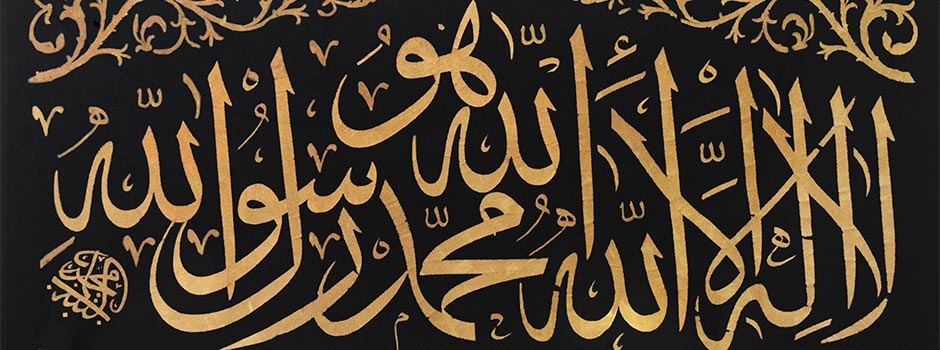
CALLIGRAPHY Mehmed Beg Kapetanovic Ljubusak – Muhibi as a Calligrapher
Jun 19, 2017 Calligraphy
This article is a part of the project 'Promotion of the Ottoman Cultural Heritage of Bosnia and Turkey' which is organized by Monolit, Association for Promoting Islamic Arts and supported by the Republic of Turkey (YTB - T.C. BAŞBAKANLIK Yurtdışı Türkler ve Akraba Topluluklar Başkanlığı / Prime Ministry, Presidency for Turks Abroad and Related Communities).
It is not known with whom he studied calligraphy, he signed his works with the pseudonym Muhibi. Four of his calligraphy works (levhas) are preserved. The oldest one dates from 1884-85 / h. 1302 and is located at the Gazi Husrev Beg Madrasa, in the great chamber, now the Museum of Gazi Husrev Beg. The second levha (1889-90 / h. 1307) is located at the Gazi Husrev Beg Library. The third levha (1892-93 / h. 1310) is owned by the Museum of the City of Sarajevo and is currently located in the great chamber of the Svrzo's House in Sarajevo. Muhibi dedicated this calligraphy to famous Sarajevo physician Dr. Bajer. The fourth calligraphy (1895-96 / h. 1313), one of the largest levhas in Bosnia and Herzegovina, is located in the Gazi Husrev Beg Mosque in Sarajevo, on the west wall in the ground floor, under the main dome. (Sources: Mazalic, Lexicon of the Artists, 69.; Balic, The Culture of Bosniaks, 174.; Mujezinovic, Islamic Epigraphy, I, 526-527.; Dervish. Muhamed B. Korokut "Oriental inscriptions on objects of the Ethnographic Collection of the Museum of Sarajevo," in: Contributions to the study of the history of Sarajevo, Vol. I, (1963), 85-100.)
 Levha by Mehmed Beg Kapetanovic Ljubusak – Muhibi at the Gazi Husrev Beg Mosque / Photo courtesy of Dr. Meliha Teparic
Levha by Mehmed Beg Kapetanovic Ljubusak – Muhibi at the Gazi Husrev Beg Mosque / Photo courtesy of Dr. Meliha Teparic
-IslamicArtsMagazine.jpg) Levha by Ljubusak at the Gazi Husrev Beg Mosque, interior / Photo © Islamic Arts Magazine
Levha by Ljubusak at the Gazi Husrev Beg Mosque, interior / Photo © Islamic Arts Magazine
Ljubusak's calligraphy opus is primarily known by his large dimensions levhas, of which only the levha in Svrzo's house is of smaller dimensions. He preferred working with gold on a dark background, which is characteristic of all his works. It can be said that his favourite calligraphic style was jali thuluth as all of his calligraphy works were written in that style. None of his known works was created by traditional calligraphy technique - with pen and ink. The levha from Svrzo's House was made with technique of applying paint probably with a brush, the other two were created by using print technique (from the Gazi Husrev-Beg Mosque and the Gazi Husrev Beg Library) and the one currently located at the Museum of Gazi Husrev Beg has leather letters.
 Levha by Mehmed Beg Kapetanovic Ljubusak – Muhibi at the Gazi Husrev Beg Library / Photo courtesy of Dr. Meliha Teparic
Levha by Mehmed Beg Kapetanovic Ljubusak – Muhibi at the Gazi Husrev Beg Library / Photo courtesy of Dr. Meliha Teparic
-IslamicArtsMagazine.jpg) Levha by Mehmed Beg Kapetanovic Ljubusak – Muhibi at the Museum of Gazi Husrev Beg / Photo © Islamic Arts Magazine
Levha by Mehmed Beg Kapetanovic Ljubusak – Muhibi at the Museum of Gazi Husrev Beg / Photo © Islamic Arts Magazine
Looking at the calligraphic aesthetic values and proportion of letters, Ljubusak's work shows sophisticated skills, but it is difficult to give a final assessment as no work was found to be created in traditional calligraphic technique. Most of his work represent talkid or canonized calligraphic compositions that were reproduced over and over again. So it is difficult to give an assessment of his skill to compose letters. From the content aspect Ljubusak repeatedly created 'La ilahe illa Allah, Huwe, Muhammad Rasul Allah - There is no God but Allah and His Messenger is Muhammad', except the levha from the Svrzo's House that bears the following text 'Al-Nagata fi al-Sidqi - Salvation is in Sincerity'.
Ljubusak's signature has all the characteristics of signatures by trained calligraphers (hattat) and masters of calligraphy. In a small istif composition, very skilfully designed in a semicircular form, is signed 'Katabu Muhammad Muhibbi - written by Mohammed Muhibi'.
As for the decorative motifs, on individual works like the levha in the Svrzo's House, decoration is downsized to a minimum, using only pervaz lines, while the levha in the Museum of Gazi Husrev Beg has no borders nor pervaz lines. On three of his works, exception is the levha from the Svrzo's House, identical floral motif of branches appear, first in somewhat simplified form on levhas from the Museum of Gazi Husrev Beg and the Gazi Husrev Beg Mosque, while at the levha from the Gaza Husrev Beg Library this motif becomes richer in floral ornament with more naturalistic presentation. Borders on both levhas, in the Gazi Husrev Beg Mosque and the Gazi Husrev Beg Library, show grandeur, the first one is of stylized floral origin in the form of ornament that is exchanged in the frieze, while the second one has geometric character, looking like a rounded meander.
 Levha by Mehmed Beg Kapetanovic Ljubusak – Muhibi at the Svrzo's House / Photo courtesy of Dr. Meliha Teparic
Levha by Mehmed Beg Kapetanovic Ljubusak – Muhibi at the Svrzo's House / Photo courtesy of Dr. Meliha Teparic
All known levhas by Mehmed Beg Kapetanovic - Ljubusak, were made in the timeframe of ten years, at the end of the 19th century. Most of them are located in the institutions of Gazi Husrev Beg, so the conclusion could be that he was connected to these institutions. It would be of great importance if more of Ljubusak's calligraphic works would be found in order to provide deeper and more extensive analysis of his calligraphic achievement.
Comments
Add a comment